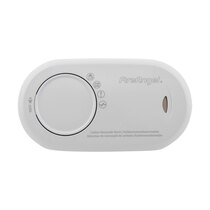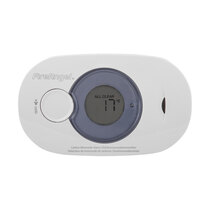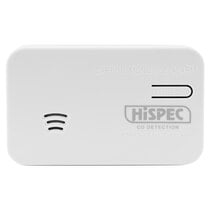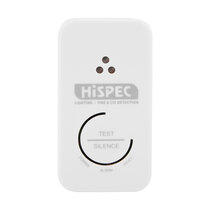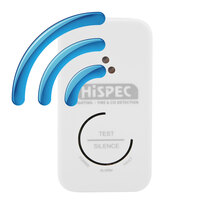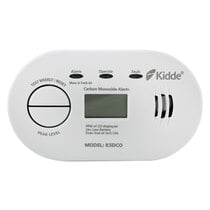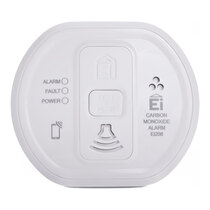-
Contact
Sales & Customer Service
0800 612 6537 support@safelincs.co.uk Live ChatDelivery Enquiries
0800 077 6149 - Resources
Fire & Safety Solutions
CALL OUR TEAM NOW 0800 612 6537
Lines open today 8am - 6pm
FREE Delivery
on marked products
Live Chat - Online
Instant help & Advice
Trade Discounts
and exclusive pricing
0% Credit Available
Open an account now
5 Star Customer Feedback
All Carbon Monoxide Detectors
Finding the Best Carbon Monoxide Detector for Your Home Choosing the best carbon monoxide detector protects your family from this silent threat. Carbon monoxide presents no smell, colour or taste, making reliable detection equipment essential for every home and workplace. Our range covers every requirement, from simple battery operated units to advanced networked systems with smartphone connectivity. Modern carbon monoxide detectors come in three main power configurations: Advanced Features in Modern CO Detectors Today's carbon monoxide alarms include sophisticated display technology to keep you aware of CO levels. LCD displays show real time readings and peak level memory. LED indicators provide clear visual status updates. Advanced models feature WiFi connectivity, sending alerts directly to your smartphone when you're away from home. Radio interlinked systems create a network of detectors throughout your property. When one carbon monoxide detector activates, all connected units sound their alarms simultaneously. This ensures you hear warnings regardless of your location within the building. Trusted Brands for Reliable Protection Our carbon monoxide detector range includes products from established manufacturers known for quality and reliability. Kidde brings decades of fire safety experience to their CO detection products. FireAngel specialises in advanced alarm technology with user focused design. UltraFire, Firehawk and Hispec complete our selection with models suited to different budgets and applications. Each CO alarm meets British Standards for carbon monoxide detection. These detectors activate at the correct thresholds to give you adequate time to respond to carbon monoxide presence. Choosing Your Carbon Monoxide Alarm Consider your property layout when selecting a CO detector system. Single detectors work well for smaller homes or specific risk areas near fuel burning appliances. Larger properties benefit from interlinked systems that communicate between floors and rooms. Properties with existing alarm systems can often integrate new carbon monoxide detection without major rewiring. Battery life varies significantly between models. Standard alkaline batteries require periodic replacement. Sealed lithium units operate for up to ten years without battery changes. Mains powered detectors with battery backup combine reliability with minimal maintenance requirements. Installation location affects detector performance. Mount units on walls at head height, away from cooking areas but close to sleeping areas. Avoid locations with excessive humidity, draughts or temperature extremes that might cause false alarms or reduce sensitivity. What to do if the carbon monoxide alarm goes off? When your carbon monoxide detector sounds, treat this as an emergency. Move everyone outside immediately and ensure fresh air reaches all occupants. Do not ignore the alarm or assume it is faulty. Once outside, call the gas emergency number on 0800 111 999 and seek medical attention if anyone feels unwell, dizzy or nauseous. Never re-enter the property until gas engineers have declared it safe. Turn off gas appliances if you can do so quickly and safely, but evacuating takes priority over everything else. Carbon monoxide poisoning symptoms include headaches, tiredness, confusion and stomach pain. These symptoms often mimic flu but without fever. Keep windows and doors open when you return to ensure continued ventilation. Have all gas appliances, flues, and chimneys checked by qualified engineers before normal use resumes. Replace the carbon monoxide detector if it continues to alarm after the source has been identified and resolved. Where should a carbon monoxide detector be placed? Position carbon monoxide alarms in rooms containing fuel burning appliances such as boilers, fires or cookers. Mount detectors on walls at head height, typically 1 to 3 metres from the appliance. Avoid placing units directly above appliances where heat and steam might cause false alarms. Install detectors in bedrooms and hallways near sleeping areas where the alarm can wake occupants. Each floor of your home should have at least one carbon monoxide alarm. Avoid locations near windows, doors or ventilation fans where draughts might prevent proper detection. Keep detectors away from bathrooms and kitchens where humidity and cooking fumes can interfere with sensors. Mount units at least 15cm from ceilings and corners where air circulation is poor. Battery powered models offer flexibility for placement, and hardwired options provide constant power. Test your detectors monthly and replace batteries annually or when low battery warnings sound. Most carbon monoxide alarms last 7 to 10 years before replacement becomes necessary. What makes the best carbon monoxide detector? The best carbon monoxide detector combines reliable sensing technology with user friendly features. Look for units meeting British Standard EN 50291 certification, which ensures proper performance and safety standards. Digital displays showing carbon monoxide levels provide valuable information beyond simple alarm functions. Long life sealed battery models eliminate the need for annual battery changes and maintain continuous protection. These units typically operate for 10 years before requiring complete replacement. Some models feature wireless connectivity, allowing multiple alarms throughout your home to sound simultaneously when one detects carbon monoxide. Voice announcements clearly identify carbon monoxide alerts, helping distinguish them from smoke alarm signals. Backlit displays remain visible in darkness, while memory functions record peak readings for later review. Consider models with smart home integration if you want remote monitoring capabilities. Many quality detectors are designed for straightforward DIY installation. Regular testing and maintenance keeps any carbon monoxide alarm functioning properly throughout its lifespan. How do I understand carbon monoxide vs carbon dioxide detection? Carbon monoxide (CO) and carbon dioxide (CO2) are different gases requiring different detection methods. Carbon monoxide results from incomplete combustion in gas appliances, vehicle engines and fires. This toxic gas prevents oxygen from reaching vital organs and can be fatal in enclosed spaces. Carbon dioxide occurs naturally in air and increases in poorly ventilated areas. While generally less dangerous than carbon monoxide, high CO2 concentrations can cause drowsiness and reduced cognitive function. Most residential properties need carbon monoxide detection rather than carbon dioxide monitoring. Carbon monoxide detectors use electrochemical sensors specifically designed to identify CO gas. These alarms typically sound when levels reach 50 parts per million over extended periods or higher concentrations more quickly. Carbon dioxide detectors measure CO2 levels and are mainly used in commercial or industrial settings. Ensure you purchase carbon monoxide detectors for home protection against gas and fuel-burning appliance hazards. These devices specifically target the deadly CO gas that threatens families each heating season across the UK.
Read more about finding the best Carbon Monoxide Detectors...
Frequently Asked Questions (FAQs)
10 Year Longlife Battery Carbon Monoxide Alarm - FireAngel FA3820
- Product Lifespan: 10 years
- Battery: 10 year sealed lithium battery
- Warranty: 5 year warranty
- Reduced test volume at a single button press
- Kitemarked to BS EN 50291-1: 2018 (domestic use)
- Kitemarked to BS EN 50291-2: 2019 (camping / caravans / boats)
- Also suitable for both the Welsh and Scottish 2022 legislation
10 Year Longlife Battery Carbon Monoxide Alarm with Digital Display - Kidde K10LLDCO
- Product Lifespan: 10 years
- Battery: Sealed-in lithium battery
- Warranty: 10 year warranty
- Digital display of CO levels from 11ppm
- Kitemarked to BS EN 50291-1: 2018 for home use
- Compliant with Scottish 2022, Welsh Landlord 2022, and Northern Ireland Landlord 2024 legislation
10 Year Longlife Battery Carbon Monoxide Alarm with Digital Display - FireAngel FA3322
- Product Lifespan: 10 years
- Battery: 10 year sealed lithium battery
- Warranty: 5 year warranty
- Sleep Easy™ and Night Time Sensing eliminate midnight battery warnings
- Digital display shows CO levels, modes, warning conditions, and temperature
- Ideal for home use and camping / caravans / boats
- Kitemarked to BS EN50291-1:2018 and BS EN50291-2:2019
- Compliant with Scottish 2022, Welsh Landlord 2022, and Northern Ireland Landlord 2024 legislation
- Suitable for new fuel-burning appliances per Building Regs Document J
10 Year Longlife Battery Carbon Monoxide Detector - Hispec HSA/BC/10
- Product Lifespan: 10 years
- Battery: 10 year sealed lithium battery
- Warranty: 5 year warranty
- Suitable for free standing or wall mounting
- Certified to BS EN 50291-1 (domestic use)
- Certified to BS EN 50291-2 (caravans / boats)
- Compliant with Scottish 2022, Welsh Landlord 2022, and Northern Ireland Landlord 2024 legislation
10 Year Longlife Battery Carbon Monoxide Alarm - Hispec
- Battery: 10 year sealed lithium battery
- Warranty: 5 year warranty
- Easy single screw installation, or leave free standing
- CE marked and Kitemarked to BS EN 50291-1
- Also suitable for both the Welsh and Scottish 2022 legislation
10 Year Longlife Battery Wireless Carbon Monoxide Alarm – Hispec RF10-PRO Range
- Battery: 10 year sealed lithium battery
- Warranty: 5 year warranty
- Radio-interlink up to 20 Hispec RF10-PRO Alarms
- CE marked and Kitemarked, suitable for Grade F1 installations
- Compatible with the Hispec Control Unit and Hispec Smoke and Heat Alarms
- Also suitable for both the Welsh and Scottish 2022 legislation
Mains Powered Carbon Monoxide Alarm with Self-Charging 10 Year Back-up Battery - Aico Ei3018
- Product Lifespan: 10 years
- Power: 230V mains powered with battery backup
- Backup Battery: Re-chargeable lithium battery
- Warranty: 5 year warranty
- AudioLINK: real time data extraction to a smart phone
- High performance electrochemical sensor
- Hardwire interlink with up to 12 compatible alarms
- Kitemarked to BS EN 50291-1: 2010
- Suitable for ceiling installation
- Also suitable for both the Welsh and Scottish 2022 legislation
Mains Powered Combined Heat and Carbon Monoxide Alarm with Self-Charging 10 Year Back-up Battery - Aico Ei3028
- Product Lifespan: 10 years
- Power: 230V mains powered with battery backup
- Backup Battery: Re-chargeable lithium battery
- Warranty: 5 year warranty
- Hardwire interlink with up to 12 compatible devices
- Compatible with Ei3000MRF SmartLINK module
- Kitemarked to BS EN 50291-1: 2010 (CO gas)
- Kitemarked to BS 5446-2: 2003 (heat)
- Suitable for ceiling installation
- Also suitable for both the Welsh and Scottish 2022 legislation
Kidde 10LLCO Carbon Monoxide Detector & 10Y29 Optical Smoke Alarm Special Offer
- FREE delivery
- 10 year battery powered CO detector
- Kitemarked to BS EN 50291-1: 2010 (domestic use)
- 10 year battery powered optical smoke alarm
- Certified to BS EN 14604: 2005
10 Year Longlife Battery Combination Optical Smoke and CO Alarm - FireAngel SCB10-R
- Product Lifespan: 10 years
- Battery: Built-in, lasts the life time of your product
- Warranty: 3 year warranty
- Combined optical smoke and carbon monoxide detector
- Ideal for hallways, bedrooms and living areas
- Sleep Easy™ function
- Kitemarked to EN 14604: 2005 (smoke detection)
- Kitemarked to EN 50291-1 (carbon monoxide detection)
- Suitable for ceiling installation
Carbon Monoxide Detector 10 Yr Life - Kidde 5CO
- Product Life: 10 years
- Battery: AA batteries included
- Warranty: 7 year warranty
- LED status display
- CE Marked
- Kitemarked to BS EN 50291-1: 2018 (domestic use)
- Also suitable for the 2022 Welsh legislation
Digital Display Carbon Monoxide Alarm 10 Yr Life - Kidde 5DCO
- Product Life: 10 years
- Battery: AA batteries included
- Warranty: 7 year warranty
- Displays CO levels from 10ppm
- Peak Level Memory - recalls highest CO levels
- CE Marked and UKCA Marked
- Kitemarked to BS EN 50291-1: 2018 (domestic use)
- Also suitable for the 2022 Welsh legislation
Carbon Monoxide Detector 10 Yr Warranty - Kidde 7CO
- Product Lifespan: 10 years
- Battery: AA batteries included
- Warranty: 10 year warranty
- Ideal for domestic use and camping / caravans / boats
- Kitemarked to BS EN50291-1
- Kitemarked to BS EN50291-2
- Also suitable for the 2022 Welsh legislation
Digital Display Carbon Monoxide Alarm 10 Yr Warranty - Kidde 7DCO
- Product Life: 10 years
- Battery: replaceable AA alkaline batteries included
- Warranty: 10 year warranty
- Displays CO levels from 10ppm
- Peak Level Memory - recalls highest CO levels
- Ideal for domestic use and camping, caravans & boats
- Kitemarked to BS EN50291-1 and BS EN50291-2
- Also suitable for the 2022 Welsh legislation
10 Year Longlife Battery Carbon Monoxide Detector - Kidde 10LLCO
- Product Lifespan: 10 years
- Battery: Built-in, lasts the life time of your product – GUARANTEED
- Warranty: 10 year warranty
- Suitable for wall mounting and free-standing
- Kitemarked to BS EN 50291-1: 2018 (domestic use)
- Also suitable for both the Welsh and Scottish 2022 legislation
10 Year Longlife Battery Digital Carbon Monoxide Alarm - Kidde 10LLDCO
- Product Lifespan: 10 years
- Battery: Built-in, lasts the life time of your product – GUARANTEED
- Warranty: 10 year warranty
- Displays CO levels from 11ppm
- Reduced sound level test feature
- Kitemarked to BS EN50291-1 (domestic use)
- Also suitable for both the Welsh and Scottish 2022 legislation
7 Year Sealed Longlife Battery Digital Carbon Monoxide Alarm - Firehawk CO7BD
- Detector battery: 7 year sealed lithium battery
- Warranty: 7 year manufacturer's warranty
- Suitable for homes, camping, caravans, and boats
- Free standing or wall mounting
- Kitemarked to BS EN50291-1 (domestic use)
- Kitemarked to BS EN50291-2 (camping / caravans / boats)
- Also suitable for both the Welsh and Scottish 2022 legislation
10 Year Longlife Battery LED Carbon Monoxide Alarm - Firehawk CO7B-10Y
- Product Life: 10 years
- Battery: Longlife lithium battery
- Warranty: 10 year warranty
- Ideal for domestic use and camping, caravans, and boats
- Kitemarked to BS EN 50291-1 and BS EN 50291-2
- Compliant with Scottish 2022, Welsh Landlord 2022, and Northern Ireland Landlord 2024 legislation
10 Year Longlife Battery Radio-Interlinked Carbon Monoxide Alarm - FireAngel Pro Connected FP1820W2-R
- Product Lifespan: 10 years
- Battery: Built-in, lasts the lifetime of your alarm
- Warranty: 5 year warranty
- Can interlink with any Wi-Safe 2 compatible device
- Suitable for free standing or wall mounting
- Kitemarked to BS EN 50291-1 (domestic use)
- Kitemarked to BS EN 50291-2 (camping / caravans / boats)
- Compliant with Scottish 2022, Welsh Landlord 2022, and Northern Ireland Landlord 2024 legislation
10 Year Life Carbon Monoxide Alarm with Long Life Lithium Battery - Ei208
- Product Lifespan: 10 years
- Battery: Built-in, lasts the life time of your product
- Warranty: 5 year warranty
- Combined Test & Hush button with low-volume test function
- Kitemarked to BS EN50291-1 (domestic use)
- Kitemarked to BS EN50291-2 (camping / caravans / boats / travel)
- Also suitable for both the Welsh and Scottish 2022 legislation
Page 2 (40 of 45 Products)
What is Carbon Monoxide (CO)?
Carbon monoxide is a colourless, odourless and tasteless gas that is extremely harmful to humans and animals. Carbon monoxide (CO) is created as a by-product of incomplete combustion of fuels containing carbon such as wood, gas, oil, etc. It occurs, if boiler flues are getting blocked, chimneys close up or if gas flames are not correctly adjusted. Even a slight increase in carbon monoxide levels can have serious health implications, therefore you should get a carbon monoxide detector to find out if you have CO in your building. If your detector goes off, switch off all fuel burning appliances, open all windows and leave the building. You then need to call your gas provider.
What are the symptoms of Carbon Monoxide poisoning?
The symptoms of carbon monoxide poisoning are similar to those of a cold or flu, such as a headache, nausea, dizziness, sore throat and dry cough. The seriousness of CO poisoning depends on the concentration of carbon monoxide in the air and the duration of exposure.
- At 50ppm (parts per million): an exposure for longer than 30 minutes will start to affect your health.
- At 200ppm: you will likely experience a slight headache after 2-3 hours.
- At 400ppm: you will likely experience a strong frontal headache, becoming widespread after 3 hours.
- At 800ppm: you will likely experience dizziness, nausea, convulsions - unconscious after 2 hours.
Who needs a Carbon Monoxide Detector?
There is no way of the human body detecting carbon monoxide, and just small amounts of exposure to CO can impact your health. Therefore, if you have any fuel burning appliances, you should have a carbon monoxide detector to protect yourself and your family.
Landlords are required to provide carbon monoxide detectors where there are gas burning appliances. "Ensure a carbon monoxide alarm is equipped in any room used as living accommodation which contains a fixed combustion appliance (excluding gas cookers)."
Where do you place a Carbon Monoxide Detector?
You should place a carbon monoxide detector within 1-3 metres of a fuel burning appliance to detect if carbon monoxide is getting released. Avoid placing carbon monoxide alarms near windows and doors, in bathrooms and on ceilings. Carbon monoxide alarms need to be kept away from dust, steam and exposure to air flow / weather to ensure the alarm stays in good condition and continue to detect carbon monoxide when present.
Why does my Carbon Monoxide Detector beep?
A carbon monoxide detector will beep if it detects carbon monoxide in the air. If your carbon monoxide alarm is beeping, switch off all fuel burning appliances, open all windows and leave the building. Even little exposure to carbon monoxide can lead to health issues, so you want to get out of the building as soon as possible.




















